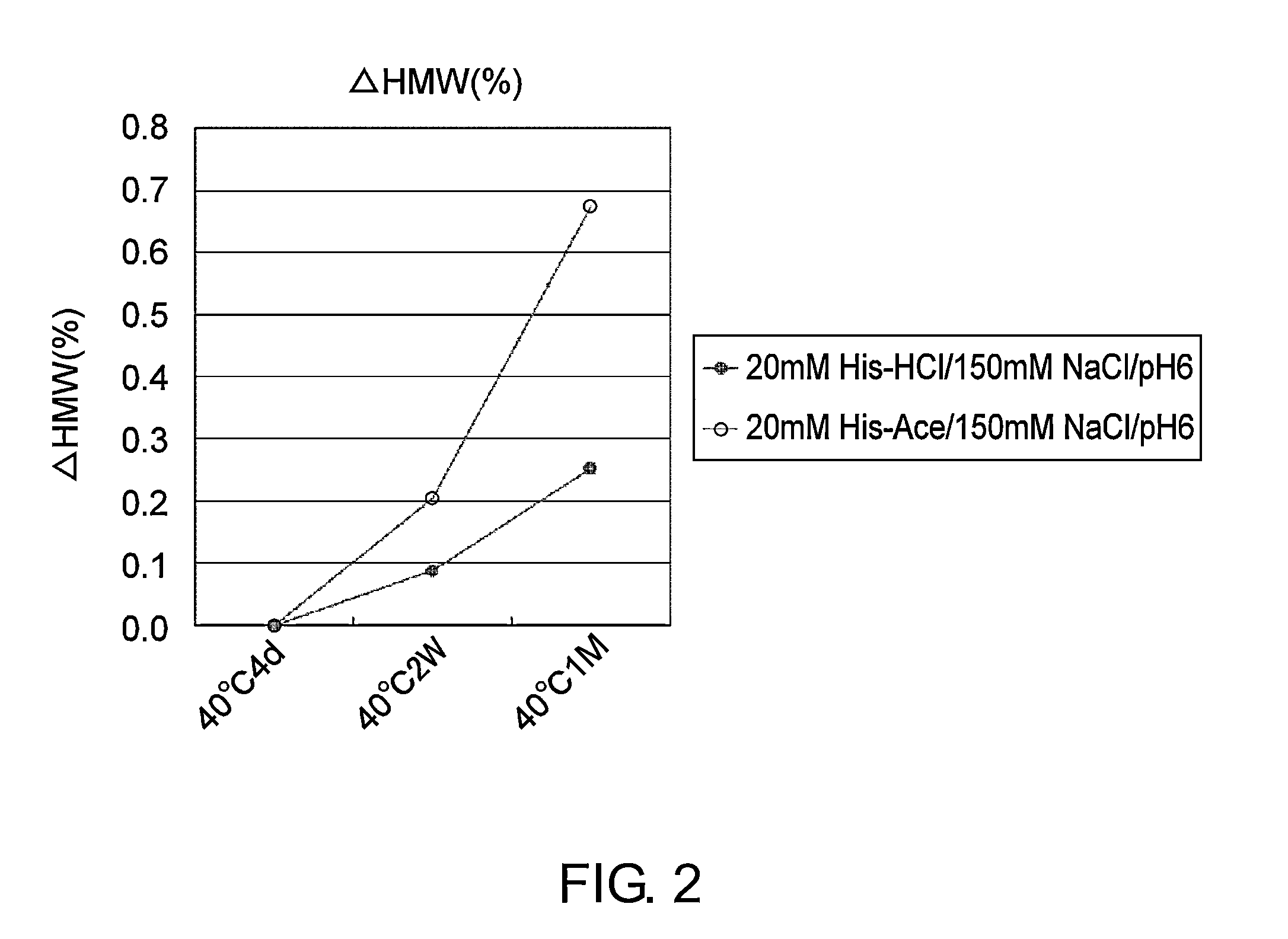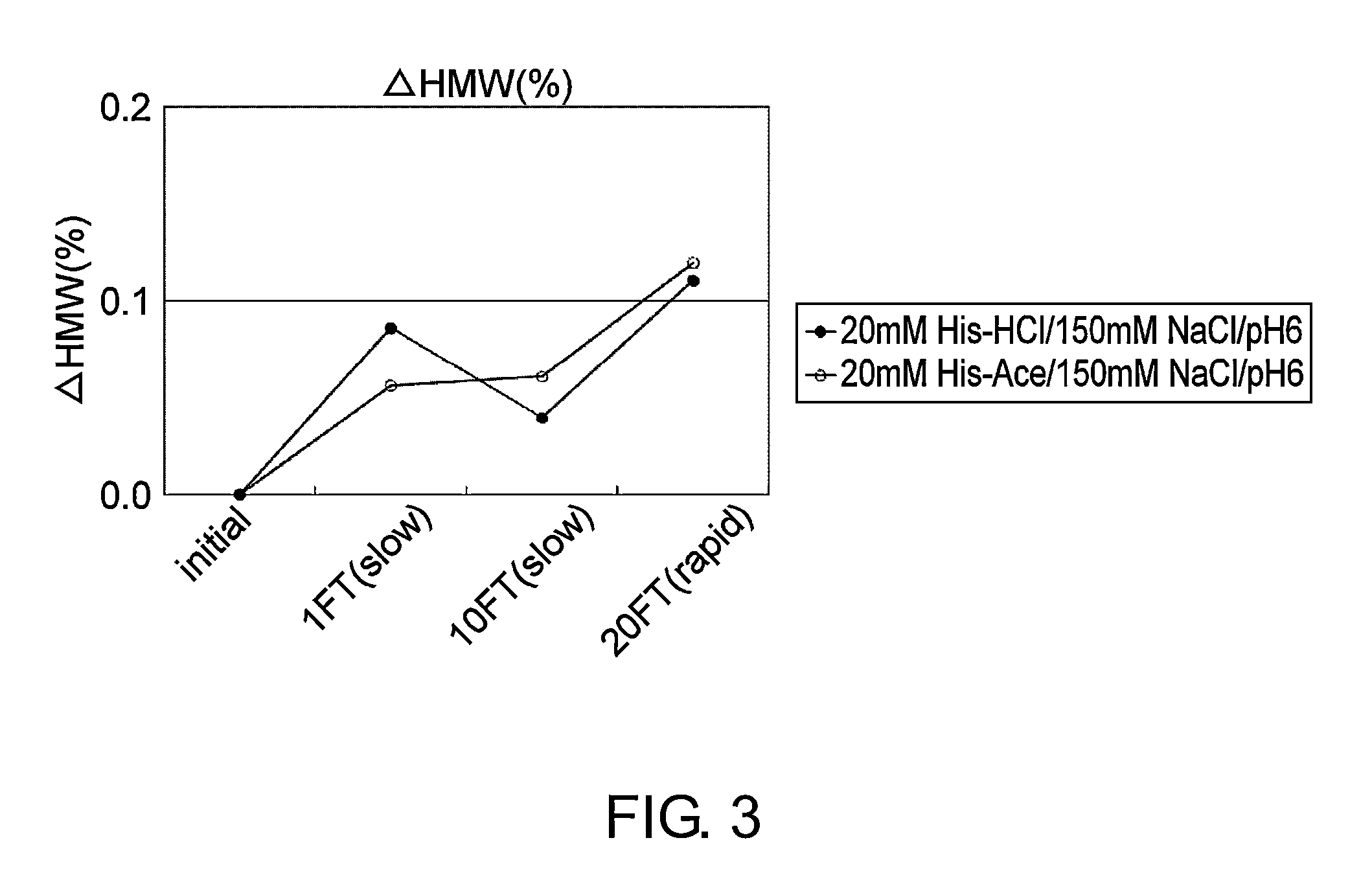Stabilized Antibody-Containing Liquid Formulations
a liquid formulation and antibody technology, applied in the field of stable highly concentrated antibody-containing formulations, can solve the problems of insufficient stability, large subcutaneous injection volume, and large concentration of highly concentrated antibody-containing liquid formulations, and achieve stable storage, improved stability, and superior stability.
- Summary
- Abstract
- Description
- Claims
- Application Information
AI Technical Summary
Benefits of technology
Problems solved by technology
Method used
Image
Examples
example 1
Assessment of the Stabilization Effect of Counter Ion Species Using Mab1 and Mab2
[0111]Mab1 (H chain / SEQ ID NO: 1; L chain / SEQ ID NO: 2) and Mab2 (H chain / SEQ ID NO: 3; L chain / SEQ ID NO: 4; tocilizumab), which are described as an anti-IL-6 receptor antibody in WO 2009 / 041621, were expressed by a method known to those skilled in the art using a stable expression CHO cell line, and then purified to high purity by a method known to those skilled in the art using protein A. Purified Mab1 and Mab2 were used in the stability study described in the Examples below.
[0112]The stability of two types of formulations, containing histidine-chloride or histidine-acetate, was assessed by freeze-thawing or by storage at 40° C. using Mab1 and Mab2. Mab1 and Mab2 formulations were prepared by overnight dialysis against each formulated solution (Table 1), followed by concentration of the solutions. The final concentrations of Mab1 and Mab2 were adjusted to 37 mg / ml. The freeze-thawing study was carrie...
example 2
Assessment of the Stabilization Effect of Counter Ion Species Using Mab1 (1)
[0115]In general, hydrochloric acid has been used as a counter ion species to histidine and arginine. According to a previous report (PCT / US2005 / 037471), results of assessing acetic acid, phosphoric acid, and sulfuric acid as a counter ion species to histidine showed that acetic acid has a superior stabilizing effect when used as a counter ion species to histidine. However, as described in Example 1 above, the present invention demonstrated that hydrochloric acid was slightly more superior than acetic acid as a counter anion species to histidine when used for Mab1 and Mab2. Hydrochloric acid is a common counter anion species, while hydrochloric acid has been reported to have a tendency of corroding stainless steel which is generally used for containers (Dent. Mater. 17:409-414 (2001); J. Pharm. Sci. 86:1250-1255 (1997)). Besides, it has been reported that the pH tends to alter in acetic acid because of its v...
example 3
Assessment of the Stabilization Effect of Counter Ion Species Using Mab2 (1)
[0120]As described in Example 1, Mab2 was found to be more stable in histidine-chloride buffer than histidine-acetate buffer (like Mab1, FIG. 2). Furthermore, as described in Example 2, the stability in liquid and frozen conditions of Mab1 was significantly improved when aspartic acid or glutamic acid was used instead of hydrochloric acid as a counter ion species to histidine and arginine. In particular, the stability in frozen conditions of Mab1 was greatly improved (to about threefold) when glutamic acid was used instead of hydrochloric acid as a counter ion species to histidine and arginine. In this context, glutamic acid and hydrochloric acid were assessed as a counter ion species to histidine for their ability to stabilize Mab2 during freeze-thawing. Arginine-containing formulations which have high stabilization effect were also assessed at the same time, and used as a control to compare the stabilizati...
PUM
 Login to View More
Login to View More Abstract
Description
Claims
Application Information
 Login to View More
Login to View More - R&D
- Intellectual Property
- Life Sciences
- Materials
- Tech Scout
- Unparalleled Data Quality
- Higher Quality Content
- 60% Fewer Hallucinations
Browse by: Latest US Patents, China's latest patents, Technical Efficacy Thesaurus, Application Domain, Technology Topic, Popular Technical Reports.
© 2025 PatSnap. All rights reserved.Legal|Privacy policy|Modern Slavery Act Transparency Statement|Sitemap|About US| Contact US: help@patsnap.com



